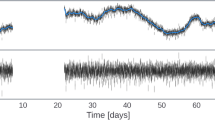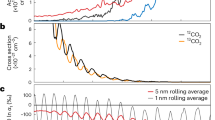Abstract
IN considering the possibility of life on other planets, we are naturally prejudiced towards some variant of the terrestrial photosynthetic mechanism, for CO2 fixation. Such a prejudice is reasonable: photosynthesis is efficient and we know that it works. But there are reasons why such a cycle may not be likely on a planet such as Mars. The chemical machinery required for photosynthesis is exceedingly complex and is unlikely to be available to the most elementary organisms. Furthermore, on many planets, such as Mars, there is a considerable flux of high energy ultraviolet radiation which reaches the planetary surface1 and which will tend to rupture bonds in organic molecules. Because photosynthetic organisms must be exposed to light, it seems unlikely that they could survive for long in the face of this radiation. It is, of course, conceivable that an organism could develop protective or self-repairing capabilities, but this would be particularly difficult for primitive life: in these conditions, life would be easiest in the shade. This would disfavour, but not exclude, an energy cycle based on photosynthesis.
This is a preview of subscription content, access via your institution
Access options
Subscribe to this journal
Receive 51 print issues and online access
$199.00 per year
only $3.90 per issue
Buy this article
- Purchase on SpringerLink
- Instant access to full article PDF
Prices may be subject to local taxes which are calculated during checkout
Similar content being viewed by others
References
Johnson, F. S., Satellite Environment Handbook, 98 (Stanford Univ. Press, 1965).
Goody, R. M., Atmosphere of Venus and Mars (edit. by Brandt, J. C., and McElroy, M. B.) (Gordon and Breach, 1968).
Bates, D. R., The Earth as a Planet (edit. by Kuyper, G. P.) (Chicago, 1964).
NAS–NRC, Biology and the Exploration of Mars, 230 (Publication 1296, 1966).
Stephenson, M., Bacterial Metabolism, third ed. (Longmans, Green, London, 1949).
Pandow, M., MacKay, C., and Wolfgang, R., J. Inorg. Nucl. Chem., 14, 153 (1960).
Belton, M. J. S., and Hunten, D. M., Astrophys. J., 153, 963 (1968).
Lederberg, J., Applied Optics, 8, 1269 (1969).
Author information
Authors and Affiliations
Rights and permissions
About this article
Cite this article
WOLFGANG, R. Carbon Monoxide as a Basis for Primitive Life on Other Planets. Nature 225, 876 (1970). https://doi.org/10.1038/225876a0
Received:
Issue date:
DOI: https://doi.org/10.1038/225876a0
This article is cited by
-
Solar-driven chemical energy source for a Martian biota
Origins of Life (1979)
-
The pyrolytic release experiment: Measurement of carbon assimilation
Origins of Life (1976)
-
Labeled release ? An experiment in radiorespirometry
Origins of Life (1976)
-
Model systems for life processes on Mars
Origins of Life (1974)
-
Carbon Monoxide as a Basis for Primitive Life on Other Planets: a Comment
Nature (1970)



